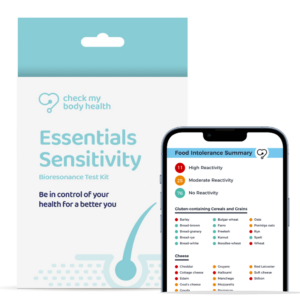
Medically reviewed by Sian Baker, Dip ION mBANT mCNHC
on December 1, 2023. To give you technically accurate, evidence-based information, content published on the Check My Body Health blog is reviewed by credentialed professionals with expertise in medical and bioscience fields.
Garlic intolerance typically causes digestive issues like bloating, gas, and stomach upset. True garlic allergy is less common but can trigger skin reactions, respiratory problems, and even severe reactions. If you experience any discomfort after eating garlic, pay attention to your symptoms. This will help determine if a simple intolerance is the culprit or if a more serious allergy might require medical attention and stricter avoidance.
Understanding Garlic’s Impact
Identifying the differences between garlic intolerance and allergy is crucial for determining the appropriate course of action. This table can help:
| Symptom Type | Garlic Intolerance | Garlic Allergy |
|---|---|---|
| Digestive | Bloating, gas, diarrhea, upset stomach | Nausea, vomiting, stomach cramps |
| Skin | Less common, but possible rashes or itchiness | Itching, redness, hives, eczema, facial swelling |
| Respiratory | Less common | Sneezing, runny nose, coughing, wheezing, shortness of breath |
| Cardiovascular | Rare | Rare, but in severe cases, blood pressure drop, anaphylaxis (life-threatening) |
Understanding The Symptoms of Garlic Intolerance and Garlic Allergy
Garlic intolerance symptoms
Digestive Distress
Individuals with garlic intolerance may experience digestive symptoms such as bloating, gas, abdominal pain, and diarrhoea after consuming garlic-containing foods. These symptoms can be indicative of an inability to digest certain compounds found in garlic.
Upset Stomach
Both intolerance and allergy can cause gastrointestinal upset, but the severity and specific symptoms may vary. Gastrointestinal symptoms may include nausea, vomiting, and stomach cramps.
Garlic allergy symptoms
Skin Reactions
Allergic reactions to garlic may manifest on the skin, leading to symptoms like itching, redness, hives, or eczema. In severe cases, individuals may experience swelling, particularly around the face and lips.
Respiratory Issues
Garlic allergy can trigger respiratory symptoms, including sneezing, nasal congestion, coughing, wheezing, or even shortness of breath. These symptoms may be a result of inhaling garlic particles or compounds released during digestion.
Cardiovascular Symptoms
In rare cases, garlic allergies can lead to cardiovascular symptoms such as a drop in blood pressure or even anaphylaxis. Anaphylaxis is a severe, life-threatening allergic reaction that requires immediate medical attention.
How to treat garlic intolerance
- Identifying and Eliminating Trigger Foods: The first step in managing garlic intolerance is to confirm you are intolerant to garlic. You can do this by taking a food intolerance test. The next step is identifying and eliminating foods that contain garlic or garlic-derived ingredients. This may involve reading food labels carefully and avoiding processed foods that may contain hidden garlic.
- Enzyme Supplements: Some individuals with garlic intolerance may benefit from enzyme supplements that help break down garlic compounds during digestion. These supplements can be taken before meals containing garlic.
- Probiotics: Probiotics, which promote a healthy balance of gut bacteria, may assist in managing digestive symptoms associated with garlic intolerance. Including probiotic-rich foods or taking supplements can be beneficial.
Garlic Intolerance Remedies
Some herbal remedies, such as peppermint or ginger tea, may help alleviate digestive symptoms associated with garlic intolerance. These herbs are known for their soothing effects on the digestive system.
Activated charcoal supplements may help absorb excess gas in the digestive tract, reducing bloating and discomfort. However, it’s crucial to use activated charcoal under the guidance of a healthcare professional.
Aloe vera, known for its anti-inflammatory properties, may be soothing for individuals experiencing gastrointestinal upset due to garlic intolerance. Aloe vera supplements or gel can be considered with caution.
Is There a Relationship Between an Intolerance to Onions and Garlic, and Why Is This?
Garlic and onions both belong to the Allium family and share similar compounds that can cause digestive distress in some individuals. The primary culprits are fructans, a type of fermentable carbohydrate that can be difficult for some people to digest. Individuals who are intolerant to onions may also experience intolerance to garlic and vice versa due to the shared presence of fructans.
Moreover, individuals with irritable bowel syndrome (IBS) or other gastrointestinal conditions may be more prone to developing sensitivities to certain foods, including garlic and onions. The fermentable nature of fructans can contribute to symptoms such as bloating, gas, and abdominal discomfort in susceptible individuals.
How Common Is a Garlic Intolerance?
The prevalence of garlic intolerance can vary among individuals and populations. While it is not as common as lactose intolerance, for example, garlic intolerance is not rare. Certain factors may increase the likelihood of developing an intolerance, including:
- Genetic Factors: Genetic predisposition may play a role in the development of food intolerances, including garlic intolerance. Individuals with a family history of food intolerances may be more susceptible.
- Gastrointestinal Conditions: Individuals with pre-existing gastrointestinal conditions, such as irritable bowel syndrome (IBS) or inflammatory bowel disease (IBD), may be at a higher risk of developing garlic intolerance.
What foods should I avoid if i have a garlic allergy or intolerance
Managing garlic intolerance involves avoiding not only fresh garlic but also processed foods that may contain garlic-derived ingredients. Here are some common sources of garlic that individuals with garlic intolerance should be cautious of:
- Fresh Garlic
- Garlic Powder
- Garlic Salt
- Garlic Oil
- Processed and Prepared Foods
Alternatives to garlic
For those with garlic allergies or intolerances, finding flavourful alternatives is key to maintaining an enjoyable and diverse diet. Here are some substitutes that can add a burst of flavour without the use of garlic:
- Garlic-Free Seasonings
- Herbs and Spices such as parsley and chives
- Citrus Zest
- Ginger and Turmeric
- Roasted Vegetables
While garlic intolerance and allergies can pose challenges, understanding the signs, symptoms, and management strategies empowers individuals to navigate their dietary choices effectively. Whether opting for garlic alternatives or exploring remedies to alleviate symptoms, individuals with garlic intolerance can enjoy a diverse and satisfying culinary experience. As with any dietary concern, consulting with a healthcare professional is essential for personalised guidance and support in managing garlic intolerance or allergies. By embracing creative alternatives and making informed choices, individuals with garlic sensitivity can savour delicious meals while prioritising their well-being.
References
1. Vitamin D. NIH, Office of Dietary Supplements. URL. Accessed February 15, 2021.
2. Nair R, Maseeh A. Vitamin D: The “sunshine” vitamin. J Pharmacol Pharmacother. 2012;3(2):118-126.
3. Vitamin D2 vs. D3: Which Should I Take for Bone Health?. Cleveland Clinic. URL. Accessed February 15, 2021.
4. Jetty V, Glueck CJ, Wang P, et al. Safety of 50,000-100,000 Units of Vitamin D3/Week in Vitamin D-Deficient, Hypercholesterolemic Patients with Reversible Statin Intolerance. N Am J Med Sci. 2016;8(3):156-162.
5. On call: Vitamin D2 or D3? Harvard Medical School. URL. Accessed February 15, 2021




